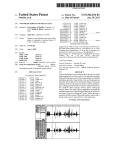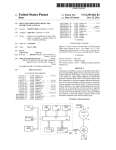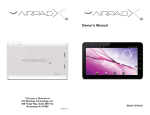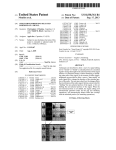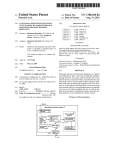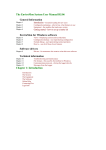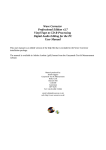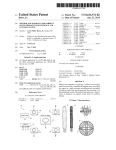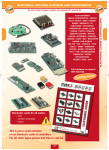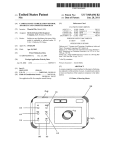Download Locating and correcting undesirable effects in signals that represent
Transcript
US007672464B2 (12) United States Patent (10) Patent N0.: (45) Date of Patent: Bianchi et al. (54) LOCATING AND CORRECTING UNDESIRABLE EFFECTS IN SIGNALS THAT REPRESENT TIME-BASED MEDIA (75) Inventors: Curt Bianchi, Saratoga, CA (US); Nikhil Bhatt, Cupertino, CA (US); Christopher Moulios, Cupertino, CA (Us) (73) Assignee: Apple Inc., Cupertino, CA (US) (*) Notice: Dec. 8, 2006 Jun. 14, 2007 Continuation of application No. 10/407,900, ?led on Apr. 4, 2003, noW Pat. No. 7,319,761. (58) OTHER PUBLICATIONS Primary ExamineriVivian Chin Assistant ExamineriDouglas J Suthers (74) Attorney, Agent, or FirmiHickman Palermo Truong & Becker LLP; Daniel D. Ledesma (57) ABSTRACT Int. Cl. H04R 29/00 H03G 7/00 G06F 17/00 G06F 3/00 G06F 3/16 (52) 6,055,495 A * 6,192,183 B1 * * cited by examiner Related US. Application Data (51) 8/1983 McMann, Jr. 4/2000 Tucker et al. ............. .. 704/210 2/2001 Taniguchi et al. ........... .. 386/52 6,403,871 B2* 6/2002 Shimizu et al. ............. .. 84/622 2003/0014135 A1 l/2003 Moulios 2004/0199277 A1 10/2004 Bianchi et al. 4,398,061 A Prior Publication Data US 2007/0135954 A1 (63) References Cited Higgins, D., “Wave Corrector v3.0 Vinyl/Tape t0 CD-R Processing Digital Audio Editing for the PC User Manual,” Jul. 22, 2004, Ganymede Test & Measurement, v3 .0, from < http://web.archive.0rg/ web/20040722l32002/WWW.Wavecor.co.uk/help300.pdf > (86 pgs). (21) App1.No.: 11/636,429 Filed: Mar. 2, 2010 U.S. PATENT DOCUMENTS Subject to any disclaimer, the term of this patent is extended or adjusted under 35 U.S.C. 154(b) by 68 days. (22) (65) (56) US 7,672,464 B2 The invention describes a graphical method for detecting and adjusting audio overload conditions. The graphical user inter face provides a user complete playback control of several audio tracks, detection of overload conditions such as audio clipping, and graphical methods to correct the overload con (2006.01) (2006.01) (2006.01) (2006.01) (2006.01) US. Cl. ......................... .. 381/56; 381/106; 700/94; ditions. The graphical interface provides drag handles Which 715/716; 715/727 the user can use to adjust the various characteristics of an Field of Classi?cation Search ................. .. 381/56, 381/106, 94.8, 94.3; 704/503; 715/727, 715/716; 700/94 See application ?le for complete search history. 135 audio ?le. The characteristics, such as amplitude and tempo, may be adjusted as a function of time. 23 Claims, 4 Drawing Sheets US. Patent Mar. 2, 2010 Sheet 1 M4 US 7,672,464 B2 Figure 1 ii US. Patent Mar. 2, 2010 Sheet 2 M4 Figure 2 210 \ US 7,672,464 B2 OBTAIN SIGNAL ABNORMALITY PATTERN 220 CHECK NEXT SEGMENT OF AUDIO DATA ABNORMALITY PATTERN IS ABNORMALITY PATTERN FOUND ? 240 ISSUE A VISUAL WARNING MARK LOCATION OF ABNORMALITY CHECK FOR END OF AUDIO DATA IF US. Patent Mar. 2, 2010 Sheet 3 0f4 US 7,672,464 B2 Figure 3 310 OBTAIN ABNORMALITIES POSITION 320 DISPLAY SIGNAL AT NEXT ABNORMALITY POSITION 340 ISSUE A VISUAL WARNING 350 \ 360 OBTAIN USER INPUT APPLY USER INPUT TO AUDIO SIGNAL AT ABNORMALITY POSITION US. Patent h4ar.2,2010 US 7,672,464 B2 Sheet40f4 v2sz EU 3% cm005 va Hg U! P. Cww;9% oQE . 2$8T625938%> modwm" as.m; #2@Q Nv ENxumEtD. US 7,672,464 B2 1 2 LOCATING AND CORRECTING UNDESIRABLE EFFECTS IN SIGNALS THAT REPRESENT TIME-BASED MEDIA FIG. 4 is an illustration of a graphical user interface (GUI) in accordance with an embodiment of the present invention. SUMMARY OF THE INVENTION CROSS-REFERENCE TO RELATED APPLICATION An embodiment of the invention is directed to a method and apparatus for locating overload conditions (e.g., clipping) in sound ?les and for graphically correcting the overload This application is a continuation of US. patent applica tion Ser. No. 10/407,900 ?ledApr. 4, 2003 now US. Pat. No. 7,319,761 which is incorporated herein by reference as fully set forth herein, under 35 U.S.C. §120. conditions. The user interface con?gured in accordance with an embodiment of the invention provides a display region that comprises a number of graphical components con?gured to assist the user with the process of determining at what point during playback of an audio ?le a sound overload condition occurred. When a sound overload condition is identi?ed, FIELD OF THE INVENTION users may then use one of the graphical components within This invention relates to the ?eld of data processing. More speci?cally, this invention relates a method and apparatus for the display region to jump to the point in the audio ?le where the abnormality exists. This enables users to quickly and ef?ciently locate and correct any sound overload conditions locating and correcting sound overload BACKGROUND OF THE INVENTION encountered during playback. 20 DETAILED DESCRIPTION Audio streams recorded as music records, sounds of live scenes or speech may sometimes contain popping sounds. A The present invention discloses a method and apparatus for popping sound is characterized by a short burst of high vol ume. It is usually introduced by faulty recording equipment, 25 badly adjusted electronic equipment, static electricity or even following description, numerous speci?c details are set forth to provide a more thorough description of the present inven tion. It will be apparent, however, to one skilled in the art, that incidents happening during the recording session (e. g. colli sions with a microphone during the recording session). Pop ping sounds may also be introduced as side effects that accompany audio data processing using numerical methods. For example, a numerical manipulation of audio data may introduce square waveforms that are the origin of the appear ance of high frequency spikes when the audio stream is passed through ?lters which are generally present in one form or another in playback devices. Popping sounds are usually uncomfortable to the human ear. It is always desirable to remove popping sounds from the present invention may practiced without these speci?c 30 Throughout this disclosure, any reference to a user may alternately refer to a person using a computer application and/or to one or more automatic processes. The automatic 35 processes may be any computer program executing locally or remotely, that communicates with embodiments of the inven tion, and that may be triggered following any predetermined 40 happens. The process may involve digitizing the audio data that can be used to locate high amplitude that surpasses a predetermined threshold, then correcting the amplitude at those locations. details. In other instances, well known features have not been described in detail so as not to obscure the present invention. audio streams, or at least attenuate their amplitude to a level that does not cause discomfort. A simple way of removing a popping sound from an audio stream is to reduce the ampli tude of the audio stream at the location where the popping locating overload conditions (e.g., clipping) in sound ?les and for graphically correcting the overload conditions. In the event. In addition, audio abnormality as used herein generally refers to saturation of the dynamic range of an audio output device. Abnormality thus encompasses saturation and its effects on the resulting audio output. FIG. 1 is a block diagram that represents the overall layout of components of a graphical user interface utilized in embodiments of the invention. One or more graphical user 45 interface (GUI) components (e.g. 120, 130, 140 and 150) are presented in one or more display areas (e.g. 110: a panel, a Existing tools for manipulating audio data do not provide means to visually and easily identify the locations where the layout container or a graphical window). A system embody amplitude of an audio stream surpasses a comfortable level of ing the invention comprises one or more audio data display listening, and allow the user to interactively alter the audio stream amplitudes at the affected locations. components 120. An audio data display component 120 50 Therefore, there is a need for a method for users to graphi viewing data. For example, component 120 allows a user to cally indicate locations of audible overload conditions, auto matically locate those locations, and allow the user to inter actively alter the audio stream. zoom in (and out) on portions (or the entirety) of the audio 55 DESCRIPTION OF THE DRAWINGS Embodiments of the invention comprise one or more audio 60 user to access and correct overload conditions in audio data. play area displays one or more audio properties. For example, area 130 may display the volume of the audio represented as a time function plotted along with the audio signal displayed in 120. Other areas may display properties such as gain, one or more ?lter properties and any other property that may be applied locally to a signal in a time dependent fashion. In the process of detecting overload conditions in audio data in embodiments of the invention. FIG. 3 is a ?owchart that illustrates steps involved in the process by which a system embodying the invention allows a data. Component 120 also allows a user to copy portions of the data from any position of the audio stream and insert it in any other position of the audio stream. properties display areas (e.g. 130 and 135). A property dis FIG. 1 is a block diagram that represents the overall layout of components of a graphical user interface utilized in embodiments of the invention. FIG. 2 is a ?owchart that illustrates steps involved in the allows easy access (e.g. through a screen pointer) to audio data for editing and viewing using several techniques for 65 example, of FIG. 1 an audio cursor 169 allows a user to interactively select a position in the audio stream. The cursor may be utilized in combination with the click of a screen US 7,672,464 B2 3 4 pointer to select portions of the audio data and/ or portions of tion. For example, some overload conditions may be due to one or more properties. One of the cursors may also be used speci?c frequencies introduced by electric (or acoustic) reso to follow the status of the audio data during playback or nance. In the latter case, it may be possible to de?ne the recording. pattern as the frequency (or a pattern of frequencies) that The system comprises other type of GUI components for visualizing the status of the audio data during playback and/or recording. For example, components 140 of FIG. 1 show two (2) vertical bars for viewing the activity of two separate stereo cause the audible effect. The system runs through the audio signal and checks each audio segment for the abnormality patterns (e.g. at step 220). When the system ?nds a location that matches the abnormality pattern (e. g. at step 230) it issues channels of an audio stream. The vertical bars utilize one or more visual cues to indicate the status of the audio data. Cues described above (e.g. at step 240). As stated above, the system one or more warnings to the user through the user interface comprise the height of a scale (e.g. 165), the color of the scale may blink the light (or change the brightness) of one or more screen widgets (e.g. 150) to indicate that the system has or of individual rows in the scale, indicating different levels of activity in the audio signal. Components 140 may have one or detected the abnormality pattern. The system records the location of every abnormality found in the audio data (e. g. at step 250) and proceeds to analyze the rest of the audio data. The system checks whether it has reached the end of the audio data (e.g. at step 260). When the test (e.g. at step 270) indi more indicators 167 that show historical values of one or more properties. For example, one or more indicators (e.g. 167) may point to the maximum, minimum or average values of the audio data during playback. A system implementing the invention is capable of detect cates the end of the audio data, the system returns a visual ing overload conditions in an audio data stream. The GUI provides display components to visually alert the user when 20 status and waits for user input (e. g. at step 280), otherwise the system continues to check the next segment of the audio data such overload conditions are detected in the audio signal. For (e.g. at step 220). example, components 150 of FIG. 1 may represent colored buttons that change the color and/ or the intensity of the light emitted by the screen component. When the system detects audio overload conditions it may send audio alerts, in addi FIG. 3 is a ?owchart that illustrates steps involved in the process by which a system embodying the invention allows a 25 in audio data, the system either runs a process that checks for tion to visual cues. matches for the abnormality pattern described above, or sim In one embodiment of the invention, status components 140 displays representation of the volume of the sound during playback. The scale 165 represents the instantaneous sound volume for each one of the stereo channels, and changes its user to access and correct overload conditions in audio data. When the user issues a command to ?nd overload conditions ply retrieves the position of matches (e.g. at step 310) found at one or more previous runs. When a position is found (or 30 color as the level of the volume rises. The indicators 167 retrieved) the system displays the portion of the signal (e.g. at step 320) in a signal display area (e.g. 120) and displays, in indicate the highest volume level ever reached from the start one or more property display areas (e.g. 130 and 135), one or of the audio playback (or recording) to the current position. more signal properties (e.g. volume, gain etc.) corresponding When the system detects an audio overload condition (e. g. in the form of a saturation level, 160), one or both components 150 light up. A user may utilize an appropriate interface control at any time to jump directly to the location of the audio signal that contains the abnormality (i.e. exceedance of the dynamic range of the audio output device). The invention provides many other graphical components to the displayed portion of the audio signal. The system may 35 nents (e.g. 150). 40 GUI components to modify the audio property at the location of an abnormality (e.g. at step 350). For example, when the abnormality is a popping (or a clicking) sound in the audio, push buttons that allow a user to automatically jump to the location of the abnormality when the system detects such 45 tively modify the audio properties by manipulating screen widgets (e.g. inside 130 and/or 135). The system registers process of detecting overload conditions in audio data in embodiments of the invention. A system embodying the invention obtains an abnormality pattern at step 210, e.g., sound pressure level limit corresponding to the dynamic range of the output device. An abnormality is typically an undesirable audible sound feature resulting from saturation and thus clipping or wrap of the resulting audio output. 50 FIG. 4 is an illustration of a graphical user interface (GUI) in accordance with an embodiment of the present invention. 55 Overload conditions may be de?ned through a description of the waveform, or using a spectral analysis based descrip The GUI of FIG. 4 comprises activity display window 410, master-playback control window 440, ?rst graphical audio data display window 450, data manipulation window 460, ?rst audio control window 420, second audio control 430, second graphical audio data display window 490, data 60 manipulation window 470, and audio cursor 480. 65 maximum decibel level indicators 414, indicator lights 416, numerical display 417, control buttons 418, and Reset button 419. Depth meters 412 provide visual displays of the sound amplitude levels in each stereo channel during playback. For Activity display window 410 comprises depth meters 412, accidentally due to faulty electrical connections or static elec tricity. Another type of overload conditions are introduced by the recording equipment, for instance recordings made using old technologies (e.g. Vinyl disks records) usually contain a recognizable cracking sound. system obtains user input (e.g. at step 350), and applies the modi?cation to the audio signal (e.g. at step 360), by chang ing the audio data, or by storing the property modi?cations along with the rest of the data. Audible overload conditions may arise from a number of sound manipulations or recording conditions. For example, during the recording, overload conditions may be introduced the signal displays an abnormally high amplitude of the wave form at the location of the popping sound. The user, in the latter example, may utilize a screen widget to modify the volume at the precise location of the popping sound. The such changes brought by the user and applies them to the audio signal at playback. FIG. 2 is a ?owchart that illustrates steps involved in the When the system ?nds an abnormality, it prepares the interface to accept user input to apply modi?cations to the audio signal’s properties. The user may utilize one or more that allow a user to access, view and edit audio data and their properties. For example, the system has one or more access abnormality. The invention also enables the user to interac display one or more cursors that indicate the exact position of the abnormality. In addition, the system issues a visual wam ing (e. g. at step 340), by activating one or more GUI compo instance, the left meter is a visual indication of the sound level in the left stereo channel while the right indicator is a visual US 7,672,464 B2 5 6 indication of the sound level in the right stereo channel. The scaling of each depth meter is such that the full scale is where sound clipping occurs. For instance, the full scale may rep and 426, respectively. And the overall gain and tempo con trols for “Untitled Track 2” are controls 434 and 436, respec tively. The waveform for “MassiveLoop.aif” is shown in window resent a sound threshold set by the user. 450 and its volume control gain is shown as a function of time in window 460. To adjust the volume as a function of time, a user clicks on waveform 462 to expose the drag control handles 464 at or near the click point. The user may then The full scale may also be limited by maximum word size used to represent the audio output device. This threshold is sometimes referred to as the clipping level. Note that embodi ments of these indicators may be built into the GUI or could be external meters connected to a computer that is processing adjust the gain either up or down using the drag control handles, e.g., 464. In similar manner, pan waveform 466 the audio ?le. Furthermore, a practitioner may omit these adjusts the left and right audio volume. Similarly, time depen dent adjustments for volume 470, tempo 474, and transpose indicators entirely since it is possible to practice the invention without them. However, the visual indication provides a warm-fuzzy of the playback activity to a user. Numerical display area 417 shows the maximum decibel 472 are possible for the second audio track “Untitled Track 2” using the click and drag method described above. Note that additional audio tracks may be added as necessary with simi lar controls. value detected during playback and its location in the track. Indicators 414 also provide visual indication of the maximum After playback, a user may use Go buttons 418 to advance cursor 480 to the next location where clipping was detected. decibel level, one for each stereo channel, which occurs in each channel during playback. For instance, if during play back the decibel level reaches minus ?ve (—5) dB on the left stereo channel, the maximum decibel level indicator 414 of the left channel will indicate a relative position of —5 dB and will remain at —5 dB even if the sound level subsequently drops down to below that level. However, if the sound level 20 subsequently increases beyond the —5 dB level, the maximum 25 indicators, e.g., indicator light 416 and numerical display level indicator will indicate the new higher level. Thus, the maximum level indicator will always show the maximum sound level attained during playback. Of course, the maxi mum sound level indicators will never show beyond the clip ping level which is the maximum scale. Values above clipping 1. A non-transitory computer-readable storage medium change of indicator lights 416. Indicator lights 416 will light up (e.g., red) any time the storing one or more sequences of instructions which, when executed by one or more processors, causes the one or more 35 usually the dynamic range of the audio output device thus is output device dependent. For example, output devices like CDs may have a 24-bit output resolution. In the digital pro cessing world, the 24 bits will represent a certain sound pressure level. Of course the sound pressure level and the signal that satisfy certain criteria, wherein the certain 40 presenting, to a user, a graphical user interface that (1) displays location information of the one or more por tions and (2) includes controls that allow the user to modify the particular signal at each of the one or more device. Thereafter, sound pressure levels above the output device limit, e. g. 24-bit value, will over?ow the output device. In one embodiment, Indicator lights 41 6 may be con?gured as momentary indicators thus indicating exceedance of the portions; receiving user input that speci?es a particularportion of the one or more portions and a change to be made to the particular portion; and 50 lights 416 will thus show when clipping occurs. Note that clipping occurs when the amplitude ratio of the audio exceeds 55 review. For instance, playback control window 440 may include a play/pause button, fast/jump forward button, characteristics that satisfy the overload condition. 60 cated gain and tempo controls. For example, the overall gain and tempo controls for “MassiveLoop.aif” are controls 424 3. The non-transitory computer-readable storage medium of claim 2, wherein the one or more portions satisfy the overload condition by having signal amplitudes that register above a predetermined threshold. project. Note that each track being processed in the project, e.g., “MassiveLoop.aif” in window 422, has its own dedi after receiving the user input, making the change to the particular portion of the particular signal to remove the undesirable effect that corresponds to the particular por tion from the particular signal. 2. The non-transitory computer-readable storage medium of claim 1, wherein: the certain criteria include an overload condition; and the one or more portions correspond to audio that has rewind/retum to start button, etc. Other control buttons may be added as needed. Playback control 440 controls playback of all audio ?les in the project. For instance, audio ?le “Mas siveLoop.aif” in window 422 and “Untitled Track 2” in win dow 432. Controls 442 and 444 in master playback control window 440 controls the beat and gain level of the audio effects, and wherein the ?le particular signal is an audio signal; output device resolution will depend on the application. Since the output device saturation limit during playback. Master Playback control window 440 comprises buttons usable for controlling playback of the audio track under processors to perform the steps of: analyZing a particular signal in a ?le to locate, within the particular signal, one or more portions of the particular criteria includes presence of one or more undesirable there is a sound pressure level corresponding to the output device bit size, any sound pressure level that reaches the maximum value set for the output device will saturate the threshold (i.e., clipping) level during playback. Indicator values 417 since these indicators latch when clipping is detected. Thus, a method and apparatus for locating and resolving sound overload conditions has been described. Particular embodiments described herein are illustrative only and should not limit the present invention thereby. The invention is de?ned by the claims and their full scope of equivalents. What is claimed is: are indicated at numerical display area 417 and by color respective channel reaches or exceeds the sound threshold level set for clipping. The sound threshold level for clipping is The top Go button may control the left stereo channel and the bottom Go button may control the right stereo channel, for example. Reset button 419 provides quick reset of all the 4. The non-transitory computer-readable storage medium 65 of claim 1, wherein the change is at least one of a change to the amplitude of the signal at the particular portion or a change to a time value associated with the particular portion. US 7,672,464 B2 8 7 maintaining position data that indicates a current posi tion within the audio ?le; 5. A method comprising the steps of: analyzing a particular signal in a ?le to locate, within the particular signal, one or more portions of the particular signal that satisfy certain criteria, wherein the certain in response to user input: reading said location information to identify a par criteria includes presence of one or more undesirable ticular location of said one or more locations; effects, and wherein the particular signal is an audio modifying the position data to cause said current posi tion to be said particular location; and signal; presenting, to a user, a graphical user interface that (1) displays location information of the one or more por tions and (2) includes controls that allow the user to modify the particular signal at each of the one or more presenting to said user one or more controls that allow said user to modify the audio data at said particular location. 14. The apparatus of claim 13, wherein audio that has characteristics that satisfy overload conditions includes audio portions; receiving user input that speci?es a particular portion of the having an abnormal signal amplitude. one or more portions and a change to be made to the 15. The apparatus of claim 13, wherein audio that has characteristics that satisfy overload conditions includes audio with a signal amplitude registering above a predetermined threshold. 16. The apparatus of claim 13, wherein said instructions particular portion; and after receiving the user input, making the change to the particular portion of the particular signal to remove the undesirable effect that corresponds to the particular por tion from the particular signal; include instructions which, when executed by the one or more wherein the steps are performed on one or more computing devices. 6. The method of claim 5, wherein: the certain criteria include an overload condition; and 20 processors, further cause the one or more processors to per the one or more portions correspond to audio that has characteristics that satisfy the overload condition. 7. The method of claim 6, wherein the one or more portions 25 satisfy the overload condition by having signal amplitudes to the user. 17. The apparatus of claim 13, wherein said instructions that register above a predetermined threshold. 8. The method of claim 5, wherein the change is at least one of a change to the amplitude of the signal at the particular portion or a change to a time value associated with the par include instructions which, when executed by the one or more processors, further cause the one or more processors to per 30 ticular portion. 9. An apparatus comprising: a display con?gured to graphically represent a particular signal that is an audio signal; a processor con?gured to analyze the particular signal to identify portions of the particular signal that satisfy cer 18. The apparatus of claim 13, wherein presenting to said user one or more controls includes providing one or more 35 ence of one or more undesirable effects; ally depicts the locations of the portions, wherein the 40 user interface comprises one or more graphical controls for adjusting the particular signal at each location, wherein at least one undesirable effect that corresponds to each location is removed from the particular signal as a a result of adjusting the particular signal. 10. The apparatus of claim 9, wherein: the certain criteria include an overload condition; and the portions correspond to audio that has characteristics that satisfy the overload condition. 11. The apparatus of claim 10, wherein the portions satisfy the overload condition by having signal amplitudes that reg drag handles con?gured to adjust at least one characteristic of said audio ?le. 19. The apparatus of claim 18, wherein said drag handles are con?gured to adjust an amplitude at said particular loca tion. 20. The apparatus of claim 18, wherein said drag handles are con?gured to adjust a time value at said particular loca tion. 21. The apparatus of claim 13, wherein said instructions include instructions which, when executed by the one or more 45 processors, further cause the one or more processors to per form the steps of: in response to user input: reading said location information to identify a new loca 50 tion of said plurality of locations, and modifying the position data to cause said current posi tion to be said new location. 22. The apparatus of claim 13, wherein analyZing the audio ister above a predetermined threshold. 12. The apparatus of claim 9, wherein adjusting the signal at each location includes at least one of adjusting to the amplitude of the signal at said each location or adjusting a time value associated with said each location. form the step of: providing said user one or more controls for automatically navigating between said one or more locations. tain criteria, wherein the certain criteria includes pres a memory in which locations of the portions are stored; and a user interface, generated as part of the display, that visu form the step of: in response to locating a particular location within the audio ?le that corresponds to audio that has characteris tics that satisfy overload conditions, presenting a visual indicator of saidparticular location within said audio ?le 55 13. An apparatus comprising: one or more processors; one or more stored sequences of instructions which, when ?le includes: playing the audio ?le back to the user; and in response to locating a particular location within the audio ?le that corresponds to audio that has characteris tics that satisfy overload conditions, presenting a visual indicator to the user. 23. The apparatus of claim 13, wherein analyZing the audio more processors to perform the steps of: analyZing an audio ?le to locate, within the audio ?le, ?le includes: playing the audio ?le back to the user; and in response to locating a particular location within the audio ?le that corresponds to audio that has characteris one or more locations that correspond to audio that tics that satisfy overload conditions, causing a audible executed by the one or more processors, cause the one or 60 has characteristics that satisfy overload conditions; storing location information that represents said one or more locations; alert to be presented to the user. * * * * * UNITED STATES PATENT AND TRADEMARK OFFICE CERTIFICATE OF CORRECTION PATENT No. : 7,672,464 B2 APPLICATION NO. : 11/636429 : March 2, 2010 : Curt Bianchi et a1. DATED INVENTOR(S) Page 1 of 1 It is certified that error appears in the above-identi?ed patent and that said Letters Patent is hereby corrected as shown below: In column 1, line 17, after “overload” insert -- . --. In column 7, line 45, in Claim 9, delete “a a result” and insert -- a result --, therefor. Signed and Sealed this Twenty-second Day of November, 2011 David J. Kappos Director 0fthe United States Patent and Trademark O?ice










